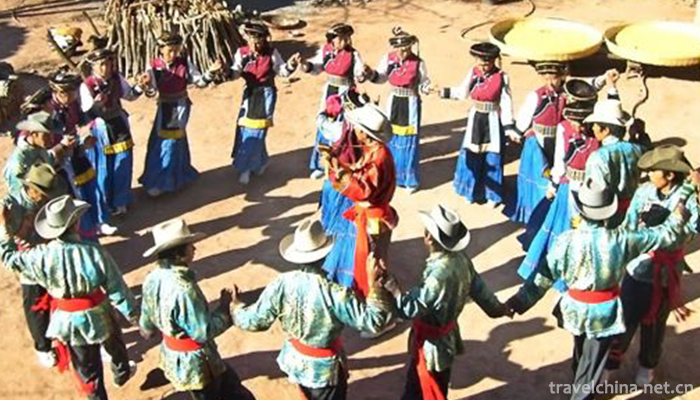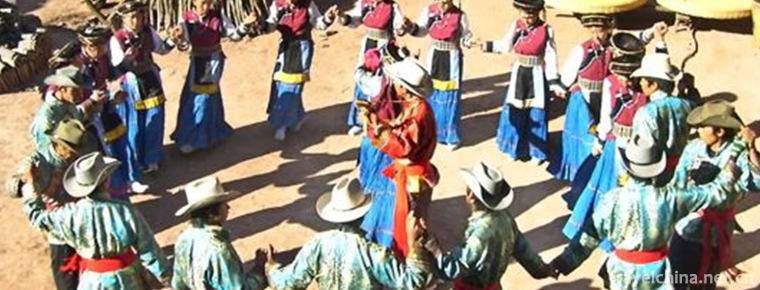Pumi rubbing
Pumi rubbing
Pumi nationality rubbing "rubbing consultation" is Pumi language, "rubbing" means dancing, "rubbing" means dancing, that is, dancing. When dancing, the leader strikes the sheepskin according to a certain rhythm, playing the effect of drumming, so it is also called "sheepskin dance". In addition, there is also the name of "four-string dance" or "Pumi Guozhuang". Mainly spread in Tongdian, Hexi, Lajing, Jinding and Shideng villages where Pumi people live together.
On June 7, 2006, "Pumi rubbing" declared by Lanping Bai Autonomous County of Yunnan Province was included in the second batch of national intangible cultural heritage list.
Heritage serial number: 675 III-78.
historical origin
The origin of "rubbing" can not be traced to history. Folklore tells us that in a war, the Pumi ancestors lit bonfires at night and danced "rubbing" all night long, which made the enemy mistake them for numerous people and horses, and eventually withdrew from the enemy. According to the old artists, the traditional "rubbing" dance has 72 tunes, i.e. 72 sets of changes in dance steps, but only 12 sets of "reunion dance", "bowl chopsticks dance", "similar dance", "shoe-sole dance", "arm-to-arm dance" and "end dance" remain.
artistic characteristics
artistic form
There are twelve sets of rubbing and negotiating dances, but after a long period of circulation, dancing steps have developed everywhere, and different dancing steps are increasing day by day. Nevertheless, there are many similarities and differences in expressive techniques, and the sound type and rhythm are basically fixed. This is a description of the twelve sets of dance steps in Longtang, Tongdian and Waterfront before the 1960s. Its main characteristics are: the force of stamping is vertical (focus on the forefoot of the center of gravity), the force of striding (walking) is horizontal (force point in the crotch), forward bending when regression, reverse upper and lower body strength, backward (natural) when upward and forward, reverse upper and lower body strength (force point in the abdomen position). The representative programs of vertical relationship are "Dengbu Langla" (one foot and two feet); the representative programs of horizontal relationship are "steep worship needs Xu Zhi" (hip-to-hip dance); and the representative programs of opposite force (upper and lower body) are the first dance method of "synthesize" (reunion dance).
The speed is generally medium. When the speed is slow, the dance steps are light and sprinkled, as if the breeze is rhythmically affecting the dress. When the speed increases, the dance steps are rough and powerful.
Formation, mainly (hand in hand) single circle, double circle and half circle, generally used to jump counterclockwise, but also clockwise. If a double circle is formed, jumps in the same direction and in different directions can be made. Dancing is not limited by time, place and number. People who participate in dancing can intervene at any time, or start one after another. Some people can dance and others can sing (folk songs) as they walk. After singing, they danced.
Artistic Characteristics
The "rubbing" dance retains the characteristics of the trinity of ancient songs, dances and music. It has a variety of names, varied formations and steps, with relaxation and relaxation. It is the Pumi people's favorite dance, widely spread, mostly used in various self-entertainment, festive fitness activities, not limited by the number of participants, few dozens of people participate, more than tens of thousands of people can dance together, to express national unity and joy, has a certain artistry.
Inheritance Significance
"Rubbing" is a happy folk dance symbolizing unity, friendship, auspiciousness and happiness. It is popular with the Pumi people and the surrounding ethnic groups, and has created a high reputation in China. Its basic contents and forms are as follows: accompanied by a four-string harp, a dancer taps the wrapped sheepskin in rhythm and produces rhythmic music accompanied by the change of dance steps. The artistic creation of "Dragon Opening Door", "Dragon Out of Water", "Dragon Turning over", "Dragon Drilling Hole", "Dragon Swinging Tail", "Dragon Holding Column", "Dragon Closing Door" and "Dragon Happiness" is twisted and twisted. Type I, team type changes quickly and smoothly, vigorous and lively, momentum, a thousand miles.


-
1.Wu zhen ancient town
Wuzhen, located in Tongxiang, Jiaxing City, Zhejiang Province, is located in the "Golden Triangle" of Jiangsu, Zhejiang and Shanghai
Time 2018-11-11 -
2.Wuxi film and television base
The Wuxi Film and Television Base of CCTV was originally built by CCTV to shoot "Tang Ming Huang", "Romance of the Three Kingdoms" and "Water Margin"
Time 2018-12-06 -
3.Yanoda Tropical Rainforest Scenic Area
Yanuoda Tropical Rainforest Scenic Area is the only tropical rainforest located at 18 degrees north latitude in China. It is the concentration of five tropical rainforests in Hainan Island
Time 2018-12-12 -
4.Beijing Hangzhou Grand Canal
Beijing-Hangzhou Grand Canal is the longest and largest ancient canal in the world. It is also one of the oldest canals. It is called three great projects in ancient China together with the Great Wall
Time 2018-12-22 -
5.Guanyin Gorge Scenic Area
Guanyinxia scenic spot is the entrance of Yulong Pass, one of the six major parks of Lijiang Bazi. It is located at the "Yulong Pass" of the three major parks of Lijiang Bazi and is known as
Time 2019-01-13 -
6.Nanxi Mountain Scenic Area Guilin
Guilin Nanxi Mountain Scenic Area (that is, Guilin Nanxi Mountain Park) is located in the south of Guilin City, about 1 kilometer north of the railway station. The two peaks of Nanxi Mountain confront
Time 2019-01-13 -
7.Longtan Park
Longtan Park is located opposite Longtan Beili District, Dongcheng District, Beijing (Chongwen District), and is currently a national 4A-level tourist park. Longtan Park
Time 2019-02-06 -
8.Bronze Repair and Reproduction Techniques
Traditional bronze repair technology mainly includes shaping, splicing, matching, bonding (welding), strengthening, old and other processes, and sometimes involves rust removal, scalding (surface seal
Time 2019-06-11 -
9.Laozi Shandong Province
Shandong Laozi is a traditional opera art form which spreads in Shandong Province. It evolved from the ancient "lotus flower falls". Laozi instruments are mainly cymbals (commonly known as G
Time 2019-06-13 -
10.Wuju Opera
Wu Opera, commonly known as Jinhua Opera, is one of the local operas in Zhejiang Province. It centers on Jinhua area and is popular in Jinhua, Lishui, Linhai, Jiande, Chun'an, Yushan, Shangrao, Guixi,
Time 2019-06-30 -
11.Yao embroidery
Yao embroidery is exquisite and delicate. Women practice flower-picking at the age of 6-7. When he grew up, he became a master of embroidery. Yao embroidery patterns are mainly used to represent trees
Time 2019-07-11 -
12.Music that Ding Zhen likes
Zhaxi Dingzhen (Chinese Name: Ding Zhen), Tibetan, lives in Litang County, Ganzi Prefecture, Sichuan Province.
Time 2020-12-07